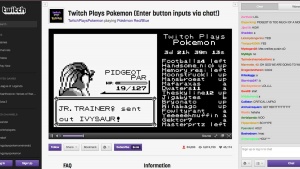Twitch Chat
Twitch Chat is a feature of the live video streaming service known as Twitch.tv, which allows viewers to interact with both the video streamer and each other in real time through the use of an integrated chatroom. Within the chatbox, viewers are able to communicate beyond the use of text in a large variety of ways with emotes, bot interactions, donations, and any other streamer specific implementations. One of the lauded strengths of Twitch.tv lies in the development and support of its chat functions, which encourage the development of close-knit communities and even sub-cultures. However, over the course of its development, Twitch Chat has been a source of controversy due to issues arsing mainly from its ephemeral nature, and anonymity it provides to its viewers.
Contents
Twitch Chat Features
Emotes
Twitch Emotes have become a large part of the Twitch community. With well over 100 global emotes usable by anyone and an ever expanding library of thousands of streamer created emotes, viewers are able to express almost any complex emotion as long as there is access to the emote. Emotes have also evolved beyond single images of faces, and have started to form a subculture "language" of sorts.[1]
Bots
As streaming on Twitch evolved to involve more aspects requiring micromanagement, the burden on the streamers and their chosen moderators rose to such a degree, that 3rd party developed automated moderators became widely adopted to lighten the workload. Depending on the quality of the bot, streamers are also able to set certain tasks that a bot will perform when a viewer types a specific command in the chat. There are other types of bots that have been developed to serve a variety of alternate purposes as well; the most notable examples being bots that periodically post complements in the chat or remind the streamer and viewers to drink water.
Bits/Cheers
In 2016, Twitch introduced a new way for viewers to donate to their favorite streamers through the purchase of "bits" which they could then spend on "cheers" in their stream of choice. To encourage the spending of these cheers, streamers implement rewards that scale according to how many cheers are spent. The most common reward is having a message read aloud by an text-to-speech bot for the streamer and other viewers to react to, but even without this specific implementation, many streams have ways to make known when a viewer subscribes, follows, or donates to their channel. This is meant to make viewers feel like they are participating, and not just watching a certain stream. [2]
Significant Events
Twitch Plays Pokemon
In February 2014, Twitch launched a social experiment in which it would try to see if order could come from chaos in a social situation. This was tested through seeing if viewers, though the use of inputting commands into the chat, could collectively beat the game, Pokemon Red Version. 16 days after the experiment began, it already had 36 million views, 1,165,140 active players, and 9 million inactive players; at its peaks, there were 100 thousand simultaneous participants.[3] After altering the methods though which inputs were handled several times, the game was finally beat in December of 2014.
AGDQ
AGDQ, or Awesome Games Done Quick, is an annual event broadcast live on Twitch.tv during which a multitude of video games are played and beaten as quick as possible using exploitable game flaws in what is called a, "Speed Run." Throughout this event, viewers are given the power to make important decisions regarding how the event is run through the use of donations, all of which go towards a predetermined charity.
Ethical Considerations
Harassment
One unfortunate aspect to Twitch chat is the amount of power and anonymity it provides. Occasionally, streams will be bombarded by individuals who post hateful or racist comments for the sake of getting a reaction out of the streamer. The impact of this bad behavior is only accentuated further by other viewers who decide to imitate this harassment without properly thinking about its full implications.[4] The only real action that can be taken against these individuals is a ban from the streamer's channel, but even then, offenders are able to make new accounts and return to harassing the streamer with little consequence. As these issues have become more frequent, Twitch has implemented systems to better prevent harassment from occurring and to keep hateful commenters off of the site.
Spamming
Spamming involves the repeated posting of non-contributory content with the intent of disrupting normal chat function in some way. Not only does spam make interaction in the chat difficult by scrolling desired information up[5], it also has the potential to cause harm to other users and the streamer if the content being spammed is also inflammatory or hateful in nature. In some cases, large amounts of spam have been known to cause buffering or even crashing of a particular stream.
Viewbots
Viewbots are artificial or fake viewers that are utilized by streamers to falsify their viewer count. The motivation for using viewbots are largely monetary, as streamers are paid based off of how many viewers watch their stream. Twitch also rewards streamers with large amounts of viewers by making them "Twitch partners," which grants access to further monetary gain and additional control over streaming capabilities. The use of viewbots a dishonest practice which not only keeps other more deserving streamers from a potential partnership, but also degrades the chat experience for actual viewers who may want to enjoy the stream.
References
- ↑ OLEJNICZAK, Jędrzej. “A LINGUISTIC STUDY OF LANGUAGE VARIETY USED ON TWITCH.TV ...” A LINGUISTIC STUDY OF LANGUAGE VARIETY USED ON TWITCH.TV: DESRIPTIVE AND CORPUS-BASED APPROACHES, May 2015, www.afahc.ro/ro/rcic/2015/rcic'15/IEL/Olejniczak.pdf.
- ↑ Anderson, Sky LaRell. “Game Studies.”, Twitch.tv and Videogame Streams, Game Studies, July 2017, [gamestudies.org/1701/articles/anderson"Game Studies - Watching People Is Not a Game: Interactive Online Corporeality"]
- ↑ Ramirez, Dennis, et al. Twitch Plays Pokemon: A Case Study in Big G Games. Authors & Digital Games Research Association DiGRA, 2014, s3.amazonaws.com/academia.edu.documents/34944676/digra2014_submission_1271.pdf?AWSAccessKeyId=AKIAIWOWYYGZ2Y53UL3A&Expires=1521374917&Signature=TilGWhVcz47G7PG39atccCEv5 o=&response-content-disposition=inline; filename=Twitch_Plays_Pokemon_A_Case_Study_in_Big.pdf.
- ↑ Seering, Joseph, et al. “Shaping Pro and Anti Social Behavior on Twitch Through ...” Shaping Pro and Anti-Social Behavior on Twitch Through Moderation and Example-Setting , CSCW, 2017, delivery.acm.org/10.1145/3000000/2998277/p111-seering.pdf?ip=73.161.232.7&id=2998277&acc=CHORUS&key=4D4702B0C3E38B35.4D4702B0C3E38B35.4D4702B0C3E38B35.6D218144511F3437&__acm__=1521419793_e779cc3c34aac007ccd83a2c0f3bb557.
- ↑ Nematzadeh, Azadeh, et al. “Information Overload in Group Communication: From Conversation to Cacophony in the Twitch Chat.” Information Overload in Group Communication: From Conversation to Cacophony in the Twitch Chat, 20 Oct. 2016, arxiv.org/abs/1610.06497v1.

